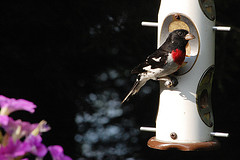This bird is known as the Rose-breasted Grosbeak which has a beautiful yet boldly patterned appearance. A common native bird of the forests across the world as well as other plantations, the Grosbeak's song is similar to the chirpy robin but it is said to be slightly smoother and more sweetly harmonious.
The colors of black, white, and rose are associated with the easily identifiable male; the drab striped female, however, is more of a challenge, resembling a large sparrow or finch.
The adult female has dark grey-brown upperparts, darker on the wings and tail and a white supercilium which can be only described as a muscular stripe along the top of the head (the eyebrow), and black-streaked white under parts.
As far as the wings are concerned, they are yellow in appearance while on the upper wing there are two white patches like in the summer male. The immature Grosbeak is harder to distinguish between sexes.
The Rose-breasted Grosbeak's breeding environment ranges across most of Canada and the northeastern part of the USA. The northern birds migrate south through the United States, east of the Rocky Mountains to winter from central-southern Mexico through to Central America and the Caribbean to South America including in Peru and Venezuela.
The first birds depart the grounds as early as August, while the last ones do not come back from their flight until mid to late May. As a rule, these birds tend to migrate south in late September or in October, and return in late April or early May. Previously these birds were migrating more during May and August instead of April or September. The Rose-breasted Grosbeak does not appear in Western Europe.
The colors of black, white, and rose are associated with the easily identifiable male; the drab striped female, however, is more of a challenge, resembling a large sparrow or finch.
The adult female has dark grey-brown upperparts, darker on the wings and tail and a white supercilium which can be only described as a muscular stripe along the top of the head (the eyebrow), and black-streaked white under parts.
As far as the wings are concerned, they are yellow in appearance while on the upper wing there are two white patches like in the summer male. The immature Grosbeak is harder to distinguish between sexes.
The Rose-breasted Grosbeak's breeding environment ranges across most of Canada and the northeastern part of the USA. The northern birds migrate south through the United States, east of the Rocky Mountains to winter from central-southern Mexico through to Central America and the Caribbean to South America including in Peru and Venezuela.
The first birds depart the grounds as early as August, while the last ones do not come back from their flight until mid to late May. As a rule, these birds tend to migrate south in late September or in October, and return in late April or early May. Previously these birds were migrating more during May and August instead of April or September. The Rose-breasted Grosbeak does not appear in Western Europe.

